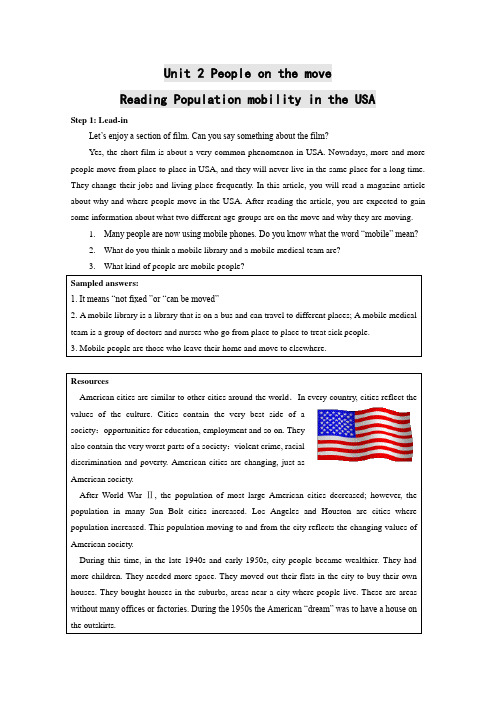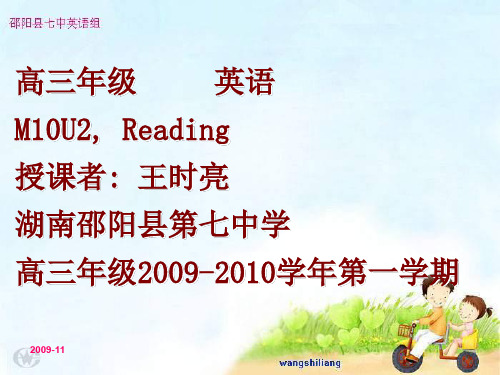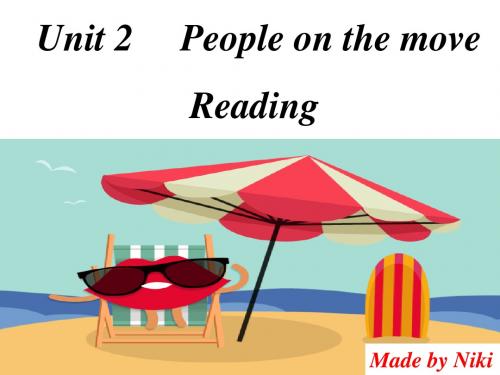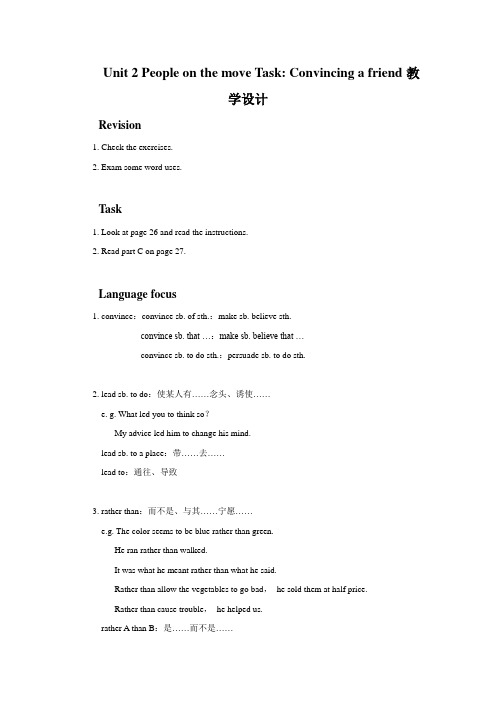牛津英语模块10 Unit2 People on the move Reading Population mobility in the USA课件
- 格式:ppt
- 大小:3.51 MB
- 文档页数:18


Unit 2 People on the moveReading Population mobility in the USAStep 1: Lead-inLet’s enjoy a section of film. Can you say something about the film?Yes, the short film is about a very common phenomenon in USA. Nowadays, more and more people move from place to place in USA, and they will never live in the same place for a long time. They change their jobs and living place frequently. In this article, you will read a magazine article about why and where people move in the USA. After reading the article, you are expected to gain some information about what two different age groups are on the move and why they are moving.1.Many people are now using mobile phones. Do you know what the word “mobile” mean?2.What do you think a mobile library and a mobile medical team are?3.What kind of people are mobile people?Sampled answers:1. It means “not fixed ”or “can be moved”2. A mobile library is a library that is on a bus and can travel to different places; A mobile medical team is a group of doctors and nurses who go from place to place to treat sick people.3. Mobile people are those who leave their home and move to elsewhere.ResourcesAmerican cities are similar to other cities around the world.In every country, cities reflect the values of the culture. Cities contain the very best side of asociety:opportunities for education, employment and so on. Theyalso contain the very worst parts of a society:violent crime, racialdiscrimination and poverty. American cities are changing, just asAmerican society.After World War Ⅱ, the population of most large American cities decreased; however, the population in many Sun Bolt cities increased. Los Angeles and Houston are cities where population increased. This population moving to and from the city reflects the changing values of American society.During this time, in the late 1940s and early 1950s, city people became wealthier. They had more children. They needed more space. They moved out their flats in the city to buy their own houses. They bought houses in the suburbs, areas near a city where people live. These are areas without many offices or factories. During the 1950s the American “dream” was to have a house on the outskirts.Now things are changing. The children of the people who left the cities in the 1950s are now adults. They, unlike their parents, want to live in the cities. Some continue to move to cities in the Sun Belt. Cities are expanding and the population is increasing in such states as Texas, Florida and California.Others are moving to more established cities of the Northeast and Midwest, such as Boston, Baltimore and Chicago.Many young professionals, doctors and lawyers are moving back into the city. They prefer the city to the suburbs because their jobs are there; they are afraid of the fuel shortage or they just enjoy the excitement and opportunities which the city offers. A new class is moving into the cities--a wealthier, more mobile class.Step 2: Fast reading for general ideasGo through the passage as quickly as possible and try to find answers to the three questions in part A on Page 18. Just focus on and identify the information needed to answer these questions. AnswersA 1 The movement of people in the USA.2 .American living3. People over 60 years and young adults.Step 3: Detailed reading for important information1. Let’s read the passage a second time and complete Parts C1 and C2 on page 20AnswersC1 1. From the Midwest and the Northeast.2. Florida.3. It is home to the largest population of people aged 65 and older. This group accounts for nearly 18 percent of the state’s population.4. Ambulance response time has been decreased and many houses have bathrooms designedfor elderly homeowners with things like walk-in bathtubs that reduce the risk of slips and falls.5. 17%6. Cities are more exciting and have more job opportunities.7. He thinks that cities are more exciting and he can meet young people like himself and goto theatres, museums and big sporting events for the entertainment.8. Five people.C2Name Age Sex Move to Reason2. Go through the text quickly and pay attention to the meaning and usage of some words. Then finish the following vocabulary exercise. Part D and Part E.3. Listen to the tape and choose the best answers according to the text:1. What is the topic of the article?A. The population of people in the USA.B. The life people in the USA.C. The beautiful scenery of USA.D. The movement of people in the USA.2. Why are young people in the USA moving to cities?A. Cities are more exciting and have more job opportunities.B. Cities are more beautiful than country.C. Young people don’t like country life.D. There are no job opportunities in country.3. Which of the following is NOT the reason for many people spending their later years in Florida?A. wanting better health care.B. looking for communities of older people.C. they like the climate there.D. they can get lot of money from the government.4. What two groups are discussed in the article?A. people over 60 years old and young adults.B. children and their parentsC. old people and their relativesD. young people who want jobs and old people.5. With the number of older Americans moving to Florida, many changes are made to cater to them. Which of the following is not the change?A. ambulance response time has decreasedB. many houses have bathrooms designed for elderly homeownersC. the communities that understands the needs of people.D. big houses with lower price.Step 3: Post-reading activities1.Pair work:(1) Discussion:What do you think about people moving to live in another place, especially moving from the countryside to a big city, or from a big city to a small town?(2) Read the instructions for Part F and discuss with the partners the following questionsStep 4: Language points:Step 6: Homework1.Read the text again and again. Try to memorize the language points.2.Exercises in Workbook.。



Unit 2 People on the move Task: Convincing a friend教学设计Revision1. Check the exercises.2. Exam some word uses.Task1. Look at page 26 and read the instructions.2. Read part C on page 27.Language focus1. convince:convince sb. of sth.:make sb. believe sth.convince sb. that …:make sb. believe that …convince sb. to do sth.:persuade sb. to do sth.2. lead sb. to do:使某人有……念头、诱使……e. g. What led you to think so?My advice led him to change his mind.lead sb. to a place:带……去……lead to:通往、导致3. rather than:而不是、与其……宁愿……e.g. The color seems to be blue rather than green.He ran rather than walked.It was what he meant rather than what he said.Rather than allow the vegetables to go bad,he sold them at half price.Rather than cause trouble,he helped us.rather A than B:是……而不是……e.g. Her age is rather over 30 than under it.Judge a student rather by what you hear than by what you see.would rather do A than do B:宁愿……而不愿……or rather:更确切地说other than:除了4. contract:n. 合同:enter into / make a contract with sb.:与……订合同break / cancel / carry out a contract:违反/ 取消/ 履行合同vt. 订合同:contract with sb.contract to do sth.vi. 收缩:Metals contract in winter.5. It is expected that ….:希望…… = Sb. / Sth. is expected to …e.g. It is expected that you hand in your exercise books by Friday.Everyone is expected to attend the meeting.Homework1. Read the passage on page 27.2. Preview ‘Project: The wandering Roma’.。
